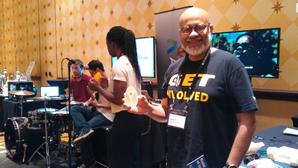By Kerri Jansen
STAFF REPORTER
Published: September 9, 2014 2:00 pm ET
Updated: September 9, 2014 2:04 pm ET

Image By: Kerri Jansen/ Plastics News
Sunand Bhattacharya, part of Autodesk's education team, displays a cutaway of a 3-D printed percussion instrument.
AUSTIN, TEXAS — At lunch during Industrial Designers Society of America’s annual conference this year, members got a taste of some inventive tunes: Musical instruments designed for additive manufacturing and printed in plastic as part of a collaborative design project called Symphony 3D.
The Symphony 3D team performed Aug. 12 at the IDSA’s annual conference in Austin, using a mix of regular instruments supplemented with 3-D printed instruments from the project.
Based around Fusion 360, cloud-based design software from AutoDesk, Symphony 3D was conceived as a way for designers and engineers from around the world to work together.
“I thought, what better way for people to collaborate, to actually communicate across language barriers, across distance, but with music,” Aaron Jackendoff of Autodesk Worldwide Education told Plastics News.
Symphony 3D is currently based at Rochester Institute of Technology, where most of the instruments have been printed.
The project is focused on creating new instruments that would be difficult to manufacture by methods other than additive manufacturing, such as a percussion instrument with interior components Jackendoff called a “shaker within a shaker.”
“The ones that are completely new, that’s what we’re really going for — the innovative, new ideas that we can get through the manufacturing and materials process,” he said.
Other instruments on display at the IDSA conference included a double-barreled whistle and a one-string lute based on an ektara from India that uses NinjaFlex flexible printing filament as the string. The team prints in primarily ABS, Jackendoff said, and had to consider the acoustical qualities and structural attributes of the material.
“One of the big things that I would like to push in the future is why is this best manufactured through 3-D printing, and how best to use the plastic as the main material,” he said, adding that other materials may be incorporated as the project grows. “For right now it’s really looking at plastic itself and what kind of opportunities it gives with the 3-D printing process.” | 